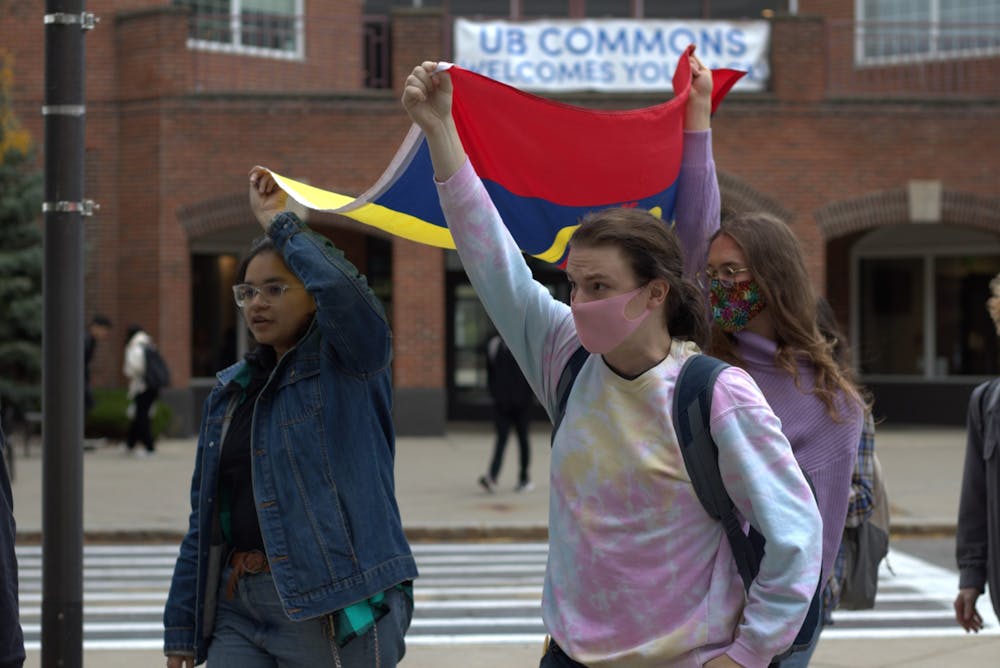Latinx enrollment at universities and post-secondary institutions in the U.S. has reached an all-time high this year.
Approximately 4.1 million Latinx adults are attending college as of 2021, according to the Pew Research Center. This number is exponentially increasing alongside the overall Latinx population, which as of 2021 is 62.5 million.
UB has the largest student population of any SUNY, but has the 41st largest percentage of Latinx students out of 61 SUNY schools.
The Spectrum compiled data regarding UB’s Latinx population in comparison to the rest of New York State and the nation.
Data collected by UB
UB reported that a total of 1,683 Latinx students were enrolled in undergraduate classes for the fall 2021 semester. Out of these Latinx students, 873 are male and 810 are female.
That’s an increase of about 400 students compared to undergraduate enrollment data from the fall 2012 that reports a total of 1,286 Latinx students.
In the last decade, UB’s Latinx undergraduate student enrollment has increased from 6.6% of the total undergraduate student population in fall 2012 to 7.8% in fall 2021, the most recent semester for which data is available.
But in comparison to other major SUNY schools, UB’s Latinx population falls below the average. Albany (18.0%), Stony Brook (14.1%), Buffalo State (12.9%) and Binghamton (12.7%) all have a significantly higher percentage of Latinx students enrolled on campus than UB.
Over 37% of Latinx UB students were enrolled in the College of Arts and Sciences in fall 2021. Latinx students only make up approximately 7.8% of total undergraduate students enrolled in the College of Arts and Sciences.
The same fall 2021 undergraduate enrollment data shows that Latinx students accounted for approximately 10.6% of students enrolled in the School of Public Health and Health Professions, approximately 7% of students enrolled in the Jacobs School of Medicine and Biomedical Sciences and 11.1% of students enrolled in the School of Architecture and Planning. Latinx students also make up 11.9% of students enrolled in combined degree programs.
According to the same data, Latinx students account for 4.4% of UB’s graduate student body.
Data collected by New York State
Data collected by the Hispanic Federation shows that New York State has approximately 3.6 million Latinx residents, the fourth largest Latinx population in the U.S. — following California, Texas and Florida.
New York’s data reported that about 27% of Latinx adults attended college and obtained an associates degree or higher in New York in 2017-18, compared to 53% of white adults.
Hispanic graduation rates were 10% lower than their non-Hispanic counterparts at two-year institutions in New York. Hispanic graduation rates were also 14% lower than their non-white counterparts at four-year institutions in New York.
Regardless of New York’s seemingly flourishing Latinx population, only about 14.5% of students enrolled at SUNYs are Latinx according to SUNY data.
The SUNYs with the highest Latinx undergraduate student enrollment are SUNY Westchester Community College (42.4%), Nassau Community College (32.8%) and Suffolk County Community College (31.1%).
SUNY College at Old Westbury ranked as the four-year SUNY with the largest portion of Latinx students at 28.4%.
“My brother graduated from Oney [SUNY Oneonta] and the school is in a really small, secluded, predominantly white town,” Jaylean V. Ureña, a sophomore aerospace engineering major and member of UB’s Latin American Student Association, said. “I’m also surprised SUNY Polytechnic Institute has more Latinos than UB just because I remember when I looked into the school it was extremely tiny. They also mostly focus on stem-like engineering, which is where Latinos tend to be underrepresented.”
Yaide Valdez, a junior political science/law major and the vice president of UB’s Latin American Student Association noticed that the further up state a SUNY school was located, the lower their Latinx student population.
“It does make me question ways that we can attract more of our Latinx population to us,” Valdez said. “As an upstater who was raised in Rochester, I do believe that there are some good quality job and internship opportunities for all students. Still, when a student feels like there is no diversity (like many SUNYs that are upstate), they become less attracted to those environments, as it is shown by the numbers.”
Valdez says that this data makes her question what UB is doing to promote diversity on campus and whether or not their tactics are working to bring in more Latinx students.
“It all can be traced back to the schools and what they are doing to promote a welcoming environment for all and not just the majority of the population, which happens to be White students,” Valdez said.
First-generation data
Latinos are more likely to be the first in their family to attend college than any other racial or ethnic group.
In the 2015-16 academic year, 44% of Latinx students were the first in their family to attend college, compared to 34% of Black students, 29% of Asian students and 22% of white students.
According to UB, approximately 18% of the undergraduate students are considered first generation.
Valdez says that as a first-generation Dominican student, she is thrilled to see growth in Hispanic presence on campus and she is proud of her community.
“As a first-generation Latina college student that attends the University at Buffalo, knowing that I am one of the 810 Hispanic/Latino students closing that bridge between a classroom and a stage means a lot,” Valdez said. “Although we are not the largest population on campus, we are willing to break the stereotypes that continue to follow us.”
Kayla Estrada is a senior news/features editor and can be reached at kayla.estrada@ubspectrum.com

Kayla Estrada is the opinion editor at The Spectrum. She is an English major who enjoys rainy weather, “Bob’s Burgers” and asking people who they voted for. When she’s not writing, she can be found hunting for odd-looking knick-knacks at the nearest thrift store.





